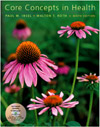Paul M. Insel,
Stanford University School of Medicine
Walton T. Roth,
Stanford University School of Medicine
| tobacco | The leaves of cultivated tobacco plants prepared for smoking, chewing, or use as snuff.
|
 |
 |
 |
| nicotine | A poisonous, addictive substance found in tobacco and responsible for many of the effects of tobacco.
|
 |
 |
 |
| secondary reinforcers | Stimuli that are not necessarily pleasurable in themselves, but that are associated with other stimuli that are pleasurable.
|
 |
 |
 |
| cigarette tar | A brown sticky mass created when the chemical particles in tobacco smoke condense.
|
 |
 |
 |
| carcinogen | Any substance that causes cancer.
|
 |
 |
 |
| cocarcinogen | A substance that works with a carcinogen to cause cancer.
|
 |
 |
 |
| cerebral cortex | The outer layer of the brain, which controls complex behavior and mental activity.
|
 |
 |
 |
| coronary heart disease (CHD) | Cardiovascular disease caused by hardening of the arteries that supply oxygen to the heart muscle; also called coronary artery disease.
|
 |
 |
 |
| atherosclerosis | Cardiovascular disease caused by the deposit of fatty substances in the walls of the arteries.
|
 |
 |
 |
| plaque | A deposit on the inner wall of blood vessels; blood can coagulate around plaque and form a clot.
|
 |
 |
 |
| angina pectoris | Chest pain due to coronary heart disease.
|
 |
 |
 |
| myocardial infarction | A heart attack caused by the complete blockage of a main coronary artery.
|
 |
 |
 |
| emphysema | A disease characterized by a loss of lung tissue elasticity and breakup of the air sacs, impairing the lungs' ability to obtain oxygen and remove carbon dioxide.
|
 |
 |
 |
| chronic bronchitis | Recurrent, persistent inflammation of the broncial tubes.
|
 |
 |
 |
| sinusitis | Inflammation of the sinus cavities; symptoms include headache, fever, and pain.
|
 |
 |
 |
| environmental tobacco smoke (ETS) | Smoke that enters the atmosphere from the burning end of a cigarette, cigar, or pipe, as well as smoke that is exhaled by smokers; also called secondhand smoke.
|
 |
 |
 |
| mainstream smoke | Smoke that is inhaled by a smoker and then exhaled into the atmosphere.
|
 |
 |
 |
| sidestream smoke | Smoke that comes from the burning end of a cigarette, cigar, or pipe.
|



 2002 McGraw-Hill Higher Education
2002 McGraw-Hill Higher Education

 2002 McGraw-Hill Higher Education
2002 McGraw-Hill Higher Education